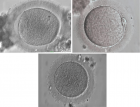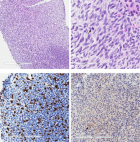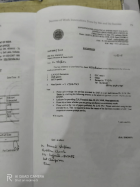Abstract
Research Article
A qualitative method for determining the surfaces between asphalt layers using ABAQUS software
Seyed Masoud Hadian*
Published: 25 April, 2019 | Volume 3 - Issue 1 | Pages: 025-031
The analytical models are mainly combined with numerical equations for the problems of the pavement under the wheel load. Different assumptions can be considered, such as elastic asphalt and viscoelastic as well as static or dynamic load. Mainly on deformation at the bottom of asphalt and tension layers focus on subgrid. The pavement structure was considered as layers with uniform characteristics. Therefore, this analytical model calculates the three-dimensional contact tension between the wheel and the pavement and the shape of the contact area. Basis and subgrid are considered linear and the asphalt layers can be linear or viscoelastic. This model is based on the results of direct shear stress tests at an axial load constant. The curves obtained from this experiment can be defined by three parameters: the maximum shear stress (shear stress curve versus shear displacement), the interaction modulus between the layers (the same curve slope) and the friction coefficient after the failure. Due to the ability of ABACOUS software, this project is done with this software. One of the methods widely used to predict viscoelastic responses of asphalt mixtures is the finite element method. ABAQUS software is one of the tools that can simulate mixed asphalt behavior based on a finite element method, taking into account all the determinant parameters. The use of the Prony series is one of the common techniques for describing the viscoelastic behavior of asphalt mixtures in ABAQUS software. For this purpose, it is necessary to determine the parameters required for this field, including proven constants, moment elastic modulus, and asphalt mixture poison ratio. On the other hand, the determination of these parameters through testing in addition to spending time and costs requires laboratory equipment. Therefore, in this thesis, a three-dimensional finite element model with ABAQUS software was constructed to analyze the persistent pavement using theoretical relations without conducting the experiment. Also, viscoelastic behavior of common asphalt mixtures and time dependence of its responses at different temperatures can be modeled in ABAQUS software. After performing the shear stress test for different axial loads, different temperatures, with or without a single coil, they found that all parameters are temperature dependent and the coefficient of friction does not depend on the applied axial load. This new model improves the accuracy of the finite element model and its important role can be an analytic expression that includes all the variables that are effective in the problem.
Read Full Article HTML DOI: 10.29328/journal.acee.1001014 Cite this Article Read Full Article PDF
Keywords:
Asphalt layers; Viscoelastic; Surfaces; Analytical model; ABAQUS software
References
- Dave N, Scofield L. Quiet Pavements Raise the Roof in Europe," Hot Mix Asphalt Technology, National Asphalt Pavement Association. 2003. Ref.: https://tinyurl.com/y2errawy
- James R. I-80 Davis OGAC Pavement Noise Study: Traffic Noise Levels Associated With an Open Grade Asphalt Concrete Overlay. Prepared for California Department of Transportation by Illingworth & Rodkin, Inc., Sacramento, CA, 2002. Ref.: https://tinyurl.com/y3wcrvhn
- Brown ER. Experience with Stone Mastic Asphalt in the United States, Report No. 93-4, National Center for Asphalt Technology, Auburn University, Alabama. 1993. Ref.: https://tinyurl.com/y3bcqocp
- Design and Construction of Stone Matrix Asphalt Mixtures. Report No. 425, National Cooperative Highway Research Program, Transportation Research Board. 1998. Ref.: https://tinyurl.com/y5t579qx
- Hughs C. Designing and Constructing SMA Mixtures - State-of-the-Practice, QIP 122, National Asphalt Pavement Association, Lanham, Maryland. 1999. Ref.: https://tinyurl.com/yyutok36
- Nunn ME, Brown A, Weston D, Nicholls JC. Design of long-life flexible pavements forheavy traffic, Report No. 250, Transportation Research Laboratory, Berkshire, United Kingdom. 1997. Ref.: https://tinyurl.com/y3wsgyfz
- Brown SF, Tam WS, Brunton JM. Structural Evaluation and Overlay Design: Analysis and Implementation. Proc., Sixth International Conference on the Structural Design of Asphalt Pavements. Ann Arbor. 1987; 1: 1013–1028. Ref.: https://tinyurl.com/yyn3myr4
- Lee HJ. Lee JH , Park HM. Performance evaluation of high modulus asphalt mixtures for longlife asphalt pavements, Department of Civil and Environmental Engineering, Sejong University, Seoul, Republic of Korea. 2005. Ref.: https://tinyurl.com/yx8n396x
- Huddleston J, Bencher M, Newcomb DE. Asphalt Pavement Alliance, Perpetual Pavement. 2004. Ref.: https://tinyurl.com/y4n58z9e
- Newcomb DE, Willis R, Timm DH. Perpetual Asphalt Pavements in America. 2010. Ref.: https://tinyurl.com/y4yd74mu
- Advanced Asphalt Technologies (AAT), LLC. Developing a Plan for Validating an Endurance Limit for HMA Pavements. Draft Executive Summary. National Cooperative Highway Research Program Project 9-44. Transportation Research Board. Washington, DC. 2007.
- Al-Qadi IL, Wang H, Yoo PJ, Dessouky SH. Dynamic Analysis and In-situ Validation of Perpetual Pavement Response to Vehicular Loading. Paper submitted to Transportation Research Board Annual Meeting. Transportation Research Board. Washington, DC. 2008; Ref.: https://tinyurl.com/y3qlaq9z
- Liao Y. Viscoelastic FE modeling of asphalt pavements and its applications to U.S. 30 perpetual pavement. Ph.D. Dissertation, Civil Engineering Department, Ohio University, Athens, OH. 2007. Ref.: https://tinyurl.com/y3opeane
- Asphalt Pavement Alliance (APA). Perpetual Pavements. A Synthesis. APA 101, Lanham, Maryland. 2002. Ref.: https://tinyurl.com/y36qqljc
- Asphalt Pavement Alliance. I-695 – a classic example of perpetual pavement. 2010.
- Pavement Design Guide, American Association of State Highway and Transportation Officials, Washington, DC. 2002. Ref.: https://tinyurl.com/y2oggarz
- Abraham H. Asphalts and Allied Substances: Their Occurrence, Modes of Production, Uses in the Arts and Methods of Testing, Third Edition. D. Van Nostrand Co., Inc. New York, NY. 1929. Ref.: https://tinyurl.com/y3ubzmdg
- Elseifi MA, Al-Qadi IL, Yoo PJ, Janajreh I. Quantification of pavement Damage Caused by Dual and Wide-Base Tires. Journal of the Transportation Research. Board No. 1940, 2005; 125-135. Ref.: https://tinyurl.com/y2bm9uhm
- Elseifi MA, Al-Qadi IL, Yoo JP. Viscoelastic Modeling and Field Validation of Flexible Pavements. ASCE Journal of Engineering Mechanics. 2006; 132: 172-178. Ref.: https://tinyurl.com/y28255gb
- Instrumentation for Flexible Pavements-Field Performance of Selected Sensors. 1992. Ref.: https://tinyurl.com/yxzbuojb
- Kim SS, Sarggand S, Masada T, Hernandez J. Ohio Department of Transportation Office of Research and Development and the United States Department of Transportation Federal Highway Administration. 2010; State Job Number 4377046.
- Liao Y, Sargand SM, Khoury IS, Harrigal A. In-Depth Investigation of the Premature Distresses of Four Ohio SHRP Test Road Sections,” 86 TRB Annual Meeting (CD-ROM), Transportation Research Board, National Research Council, Washington, DC. 2007.
- Masada T. Laboratory Characterization of Materials and Data Management for Ohio-SHRP Project (U.S. 23), Report No. FHWA/OH-2001/07, Department of Civil Engineering, Ohio University, Athens, Ohio. 2007. Ref.: https://tinyurl.com/y265wjxh
- Masada T, Sargand SM, Liao Y. Resilient Modulus Prediction Model for Fine-Grained Soils in Ohio: Preliminary Study International Conference on Perpetual Pavement (CDROM), Columbus, Ohio. 2006; Ref.: https://tinyurl.com/y3jwnzoq
- Sargand SM, Khoury IS, Romanello MT, Figueroa JL. Seasonal and Load Response Instrumentation of the Way-30 Perpetual Pavement. International Conference on Perpetual Pavement (CDROM), Columbus, Ohio.2006.
- Perpetual Bituminous Pavements. Transportation Research Circular 503, Transportation Research Board, National Research Council.
- Hernandez JA. Evaluation of the Response of Perpetual Pavement at Accelerated Pavement Loading Facility: Finite Element Analysis and Experimental Investigation, Russ College of Engineering and Technology of Ohio University , In partial fulfillment of the requirements for the degree Master of Science. 2010; Ref.: https://tinyurl.com/y2vneqhw
- Al-Qadi IL, Wang H, Yoo PJ. Dessouky SH. Dynamic analysis and in-situ validation of perpetual pavement response to vehicular loading. Transportation Research Record: J Trans Res Board. 2008; 2087: 29-39. Ref.: https://tinyurl.com/yxmmeqfe
- Garcia G, Thompson MR. Strain and pulse duration considerations for extended-life hot-mix asphalt pavement design. Transportation Research Record: J Trans Res Board. 2008; 2087: 3-11. Ref.: https://tinyurl.com/y6tboshu v
- Hornyak N, Crovetti JA. Analysis of load pulse durations for Marquette interchange instrumentation project. Transportation Research Record: J Trans Res Board. 2009; 2094: 53-61. Ref.: https://tinyurl.com/yxtppxjf
- Loulizi A, AL-Qadi IL, Elseifi M. Difference between in situ flexible pavements measured and calculated stresses and strains. J Trans Eng. ASCE. 2006; 132: 574-579. Ref.: https://tinyurl.com/yxa4e4yg
- Park D, Martin AE, Masad E. Effects of no uniform tire contact stresses on pavement response. J Trans Eng. 2005; 131: 873-879. Ref.: https://tinyurl.com/yxa5otcy
- Robbins MM, Timm DH. Proceedings from International Conference on Perpetual Pavement 2009: Effects of strain pulse duration on tensile strain in a perpetual pavement. Columbus, OH. 2009.
Similar Articles
-
A qualitative method for determining the surfaces between asphalt layers using ABAQUS softwareSeyed Masoud Hadian*. A qualitative method for determining the surfaces between asphalt layers using ABAQUS software. . 2019 doi: 10.29328/journal.acee.1001014; 3: 025-031
-
Investigation and analysis of fracture failure and fatigue cracking in High-rise pavement using simulation software of ABAQUSSeyed Masoud Hadian*. Investigation and analysis of fracture failure and fatigue cracking in High-rise pavement using simulation software of ABAQUS. . 2019 doi: 10.29328/journal.acee.1001015; 3: 032-039
-
Durability of Lumber Pretreatment Compared to Posttreatment ProcessesSolomon I Ubani*. Durability of Lumber Pretreatment Compared to Posttreatment Processes. . 2023 doi: 10.29328/journal.acee.1001056; 7: 061-066
Recently Viewed
-
Prediction of neonatal and maternal index based on development and population indicators: a global ecological studySedigheh Abdollahpour,Hamid Heidarian Miri,Talat Khadivzadeh*. Prediction of neonatal and maternal index based on development and population indicators: a global ecological study. Clin J Obstet Gynecol. 2021: doi: 10.29328/journal.cjog.1001096; 4: 101-105
-
A Genetic study in assisted reproduction and the risk of congenital anomaliesKaparelioti Chrysoula,Koniari Eleni*,Efthymiou Vasiliki,Loutradis Dimitrios,Chrousos George,Fryssira Eleni. A Genetic study in assisted reproduction and the risk of congenital anomalies. Clin J Obstet Gynecol. 2021: doi: 10.29328/journal.cjog.1001095; 4: 096-100
-
Leiomyosarcoma in pregnancy: Incidental finding during routine caesarean sectionToon Wen Tang*,Phoon Wai Leng Jessie. Leiomyosarcoma in pregnancy: Incidental finding during routine caesarean section. Clin J Obstet Gynecol. 2021: doi: 10.29328/journal.cjog.1001094; 4: 092-095
-
Adult Neurogenesis: A Review of Current Perspectives and Implications for Neuroscience ResearchAlex, Gideon S*,Olanrewaju Oluwaseun Oke,Joy Wilberforce Ekokojde,Tolulope Judah Gbayisomore,Martina C. Anene-Ogbe,Farounbi Glory,Joshua Ayodele Yusuf. Adult Neurogenesis: A Review of Current Perspectives and Implications for Neuroscience Research. J Neurosci Neurol Disord. 2024: doi: 10.29328/journal.jnnd.1001102; 8: 106-114
-
Late discover of a traumatic cardiac injury: Case reportBenlafqih C,Bouhdadi H*,Bakkali A,Rhissassi J,Sayah R,Laaroussi M. Late discover of a traumatic cardiac injury: Case report. J Cardiol Cardiovasc Med. 2019: doi: 10.29328/journal.jccm.1001048; 4: 100-102
Most Viewed
-
Evaluation of Biostimulants Based on Recovered Protein Hydrolysates from Animal By-products as Plant Growth EnhancersH Pérez-Aguilar*, M Lacruz-Asaro, F Arán-Ais. Evaluation of Biostimulants Based on Recovered Protein Hydrolysates from Animal By-products as Plant Growth Enhancers. J Plant Sci Phytopathol. 2023 doi: 10.29328/journal.jpsp.1001104; 7: 042-047
-
Sinonasal Myxoma Extending into the Orbit in a 4-Year Old: A Case PresentationJulian A Purrinos*, Ramzi Younis. Sinonasal Myxoma Extending into the Orbit in a 4-Year Old: A Case Presentation. Arch Case Rep. 2024 doi: 10.29328/journal.acr.1001099; 8: 075-077
-
Feasibility study of magnetic sensing for detecting single-neuron action potentialsDenis Tonini,Kai Wu,Renata Saha,Jian-Ping Wang*. Feasibility study of magnetic sensing for detecting single-neuron action potentials. Ann Biomed Sci Eng. 2022 doi: 10.29328/journal.abse.1001018; 6: 019-029
-
Pediatric Dysgerminoma: Unveiling a Rare Ovarian TumorFaten Limaiem*, Khalil Saffar, Ahmed Halouani. Pediatric Dysgerminoma: Unveiling a Rare Ovarian Tumor. Arch Case Rep. 2024 doi: 10.29328/journal.acr.1001087; 8: 010-013
-
Physical activity can change the physiological and psychological circumstances during COVID-19 pandemic: A narrative reviewKhashayar Maroufi*. Physical activity can change the physiological and psychological circumstances during COVID-19 pandemic: A narrative review. J Sports Med Ther. 2021 doi: 10.29328/journal.jsmt.1001051; 6: 001-007

HSPI: We're glad you're here. Please click "create a new Query" if you are a new visitor to our website and need further information from us.
If you are already a member of our network and need to keep track of any developments regarding a question you have already submitted, click "take me to my Query."



















































































































































